
The next two chapters provide a deeper look into how to manage data. There are two different approaches that complement each other: Unified Shared Memory (USM) and buffers. USM exposes a different level of abstraction for memory than buffers—USM has pointers, and buffers are a higher-level interface. This chapter focuses on USM. The next chapter will focus on buffers.
Unless we specifically know that we want to use buffers, USM is a good place to start. USM is a pointer-based model that allows memory to be read and written through regular C++ pointers.
Why Should We Use USM?
Since USM is based on C++ pointers, it is a natural place to start for existing pointer-based C++ codes. Existing functions that take pointers as parameters continue to work without modification. In the majority of cases, the only changes required are to replace existing calls to malloc or new with USM-specific allocation routines that we will discuss later in this chapter.
Allocation Types
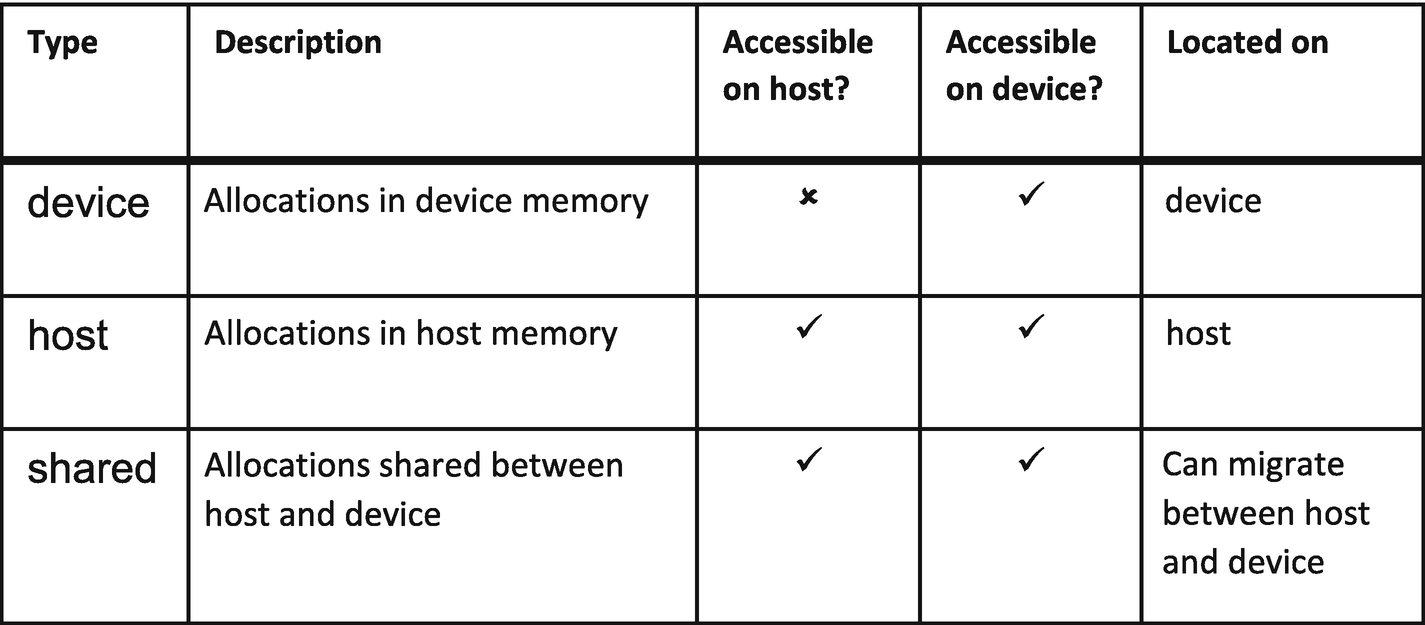
USM allocation types
Device Allocations
This first type of allocation is what we need in order to have a pointer into a device’s attached memory, such as (G)DDR or HBM. Device allocations can be read from or written to by kernels running on a device, but they cannot be directly accessed from code executing on the host. Trying to access a device allocation on the host can result in either incorrect data or a program crashing due to an error. We must copy data between host and device using the explicit USM memcpy mechanisms , which specify how much data must be copied between two places, that will be covered later in this chapter.
Host Allocations
This second type of allocation is easier to use than device allocations since we do not have to manually copy data between the host and the device. Host allocations are allocations in host memory that are accessible on both the host and the device. These allocations, while accessible on the device, cannot migrate to the device’s attached memory. Instead, kernels that read from or write to this memory do it remotely, often over a slower bus such as PCI-Express. This tradeoff between convenience and performance is something that we must take into consideration. Despite the higher access costs that host allocations can incur, there are still valid reasons to use them. Examples include rarely accessed data or large data sets that cannot fit inside device attached memory.
Shared Allocations
The final type of allocation combines attributes of both device and host allocations, combining the programmer convenience of host allocations with the greater performance afforded by device allocations. Like host allocations, shared allocations are accessible on both the host and device. The difference between them is that shared allocations are free to migrate between host memory and device attached memory, automatically, without our intervention. If an allocation has migrated to the device, any kernel executing on that device accessing it will do so with greater performance than remotely accessing it from the host. However, shared allocations do not give us all the benefits without any drawbacks.
Automatic migration can be implemented in a variety of ways. No matter which way the runtime chooses to implement shared allocations, they usually pay a price of increased latency. With device allocations, we know exactly how much memory needs to be copied and can schedule the copy to begin as quickly as possible. The automatic migration mechanisms cannot see the future and, in some cases, do not begin moving data until a kernel tries to access it. The kernel must then wait, or block, until the data movement has completed before it can continue executing. In other cases, the runtime may not know exactly how much data the kernel will access and might conservatively move a larger amount of data than is required, also increasing latency for the kernel.
We should also note that while shared allocations can migrate, it does not necessarily mean that all implementations of DPC++ will migrate them. We expect most implementations to implement shared allocations with migration, but some devices may prefer to implement them identically to host allocations. In such an implementation, the allocation is still visible on both host and device, but we may not see the performance gains that a migrating implementation could provide.
Allocating Memory
USM allows us to allocate memory in a variety of different ways that cater to different needs and preferences. However, before we go over all the methods in greater detail, we should discuss how USM allocations differ from regular C++ allocations.
What Do We Need to Know?
Regular C++ programs can allocate memory in multiple ways: new, malloc, or allocators. No matter which syntax we prefer, memory allocation is ultimately performed by the system allocator in the host operating system. When we allocate memory in C++, the only concerns are “How much memory do we need?” and “How much memory is available to allocate?” However, USM requires extra information before an allocation can be performed.
First, USM allocation needs to specify which type of allocation is desired: device, host, or shared. It is important to request the right type of allocation in order to obtain the desired behavior for that allocation. Next, every USM allocation must specify a context object against which the allocation will be made. The context object hasn’t had a lot of discussion yet, so it’s worth saying a little about it here. A context represents a device or set of devices on which we can execute kernels. We can think of a context as a convenient place for the runtime to stash some state about what it’s doing. Programmers are not likely to directly interact with contexts outside of passing them around in most DPC++ programs.
USM allocations are not guaranteed to be usable across different contexts—it is important that all USM allocations, queues, and kernels share the same context object . Typically, we can obtain this context from the queue being used to submit work to a device. Finally, device allocations also require that we specify which device will provide the memory for the allocation. This is important since we do not want to oversubscribe the memory of our devices (unless the device is able to support this—we will say more about that later in the chapter when we discuss migration of data). USM allocation routines can be distinguished from their C++ analogues by the addition of these extra parameters.
Multiple Styles
Sometimes, trying to please everyone with a single option proves to be an impossible task, just as some people prefer coffee over tea, or emacs over vi. If we ask programmers what an allocation interface should look like, we will get several different answers back. USM embraces this diversity of choice and provides several different flavors of allocation interfaces. These different flavors are C-style, C++-style, and C++ allocator–style. We will now discuss each and point out their similarities and differences.
Allocations à la C
The first style of allocation functions (listed in Figure 6-2, later used in examples shown in Figures 6-6 and 6-7) is modeled after memory allocation in C: malloc functions that take a number of bytes to allocate and return a void * pointer. This style of function is type agnostic. We must specify the total number of bytes to allocate, which means if we want to allocate N objects of type X, one must ask for N * sizeof(X) total bytes. The returned pointer is of type void *, which means that we must then cast it to an appropriate pointer to type X. This style is very simple but can be verbose due to the size calculations and typecasting required.
We can further divide this style of allocation into two categories : named functions and single function. The distinction between these two flavors is how we specify the desired type of USM allocation. With the named functions (malloc_device, malloc_host, and malloc_shared), the type of USM allocation is encoded in the function name. The single function malloc requires the type of USM allocation to be specified as an additional parameter. Neither flavor is better than the other, and the choice of which to use is governed by our preference.
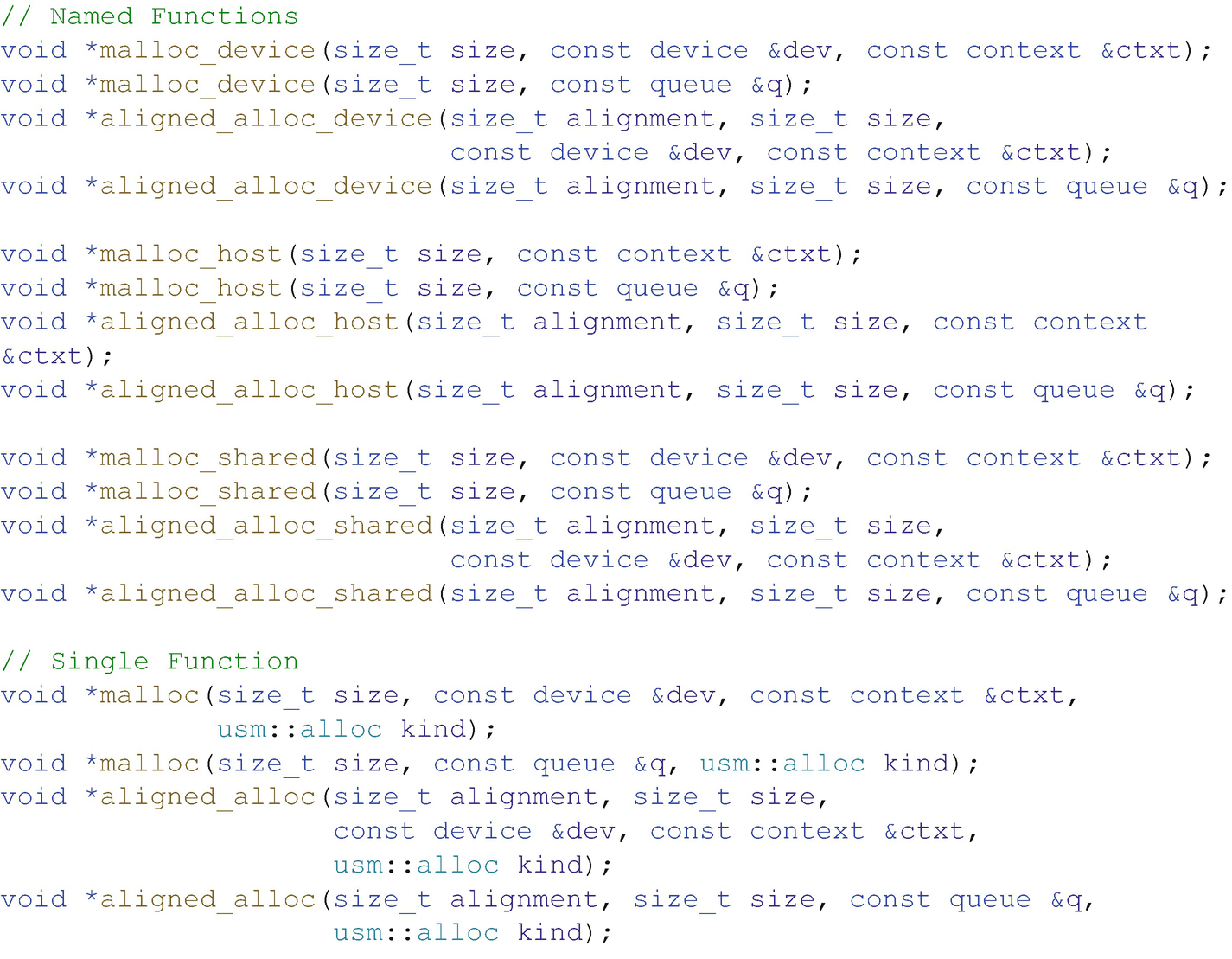
C-style USM allocation functions
Allocations à la C++
The next flavor of USM allocation functions (listed in Figure 6-3) is very similar to the first but with more of a C++ look and feel. We once again have both named and single function versions of the allocation routines as well as our default and user-specified alignment versions. The difference is that now our functions are C++ templated functions that allocate Count objects of type T and return a pointer of type T *. Taking advantage of modern C++ simplifies things, since we no longer need to manually calculate the total size of the allocation in bytes or cast the returned pointer to the appropriate type. This also tends to yield a more compact and less error-prone expression in code. However, we should note that unlike “new” in C++, malloc-style interfaces do not invoke constructors for the objects being allocated—we are simply allocating enough bytes to fit that type.
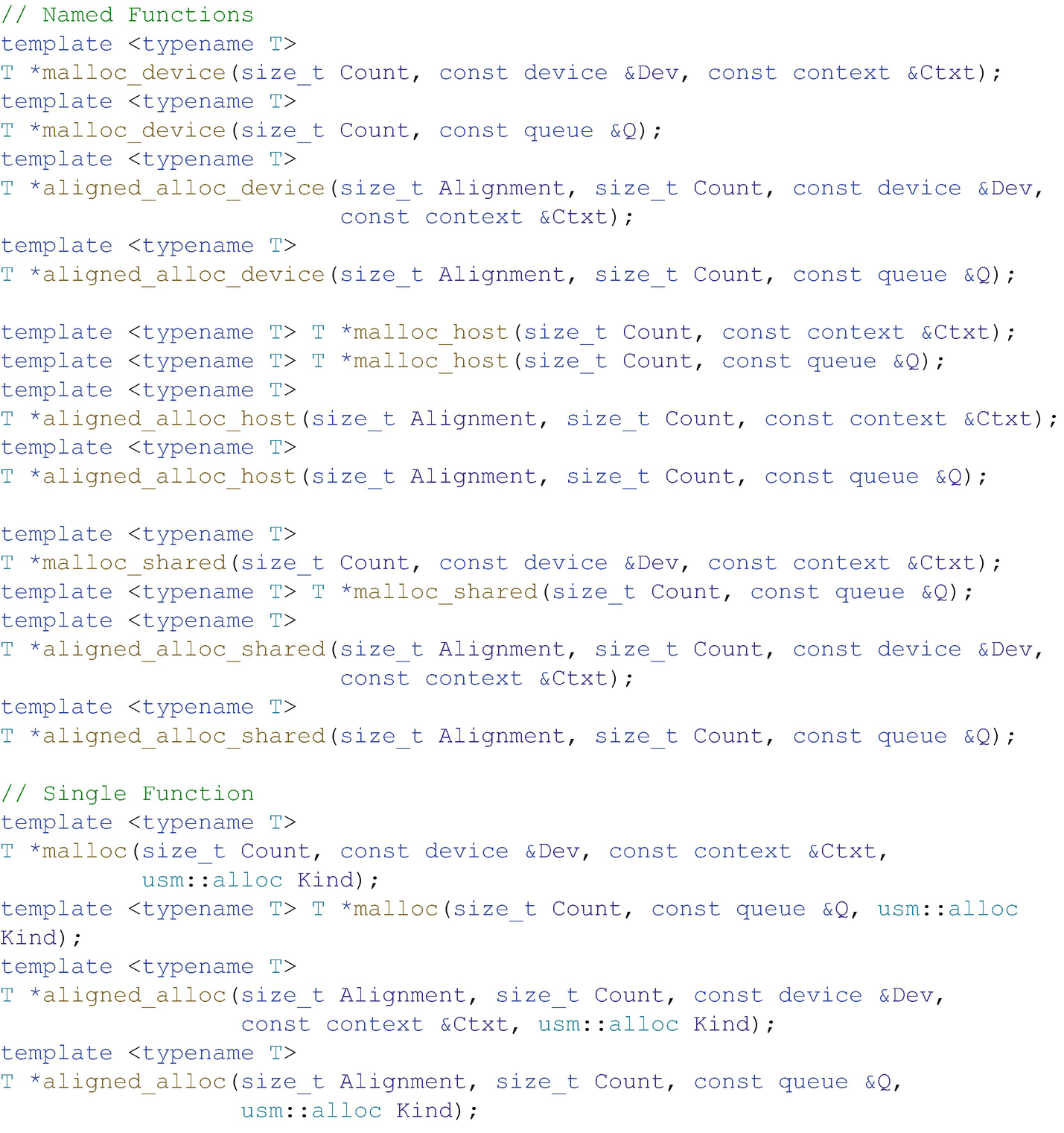
C++-style USM allocation functions
C++ Allocators
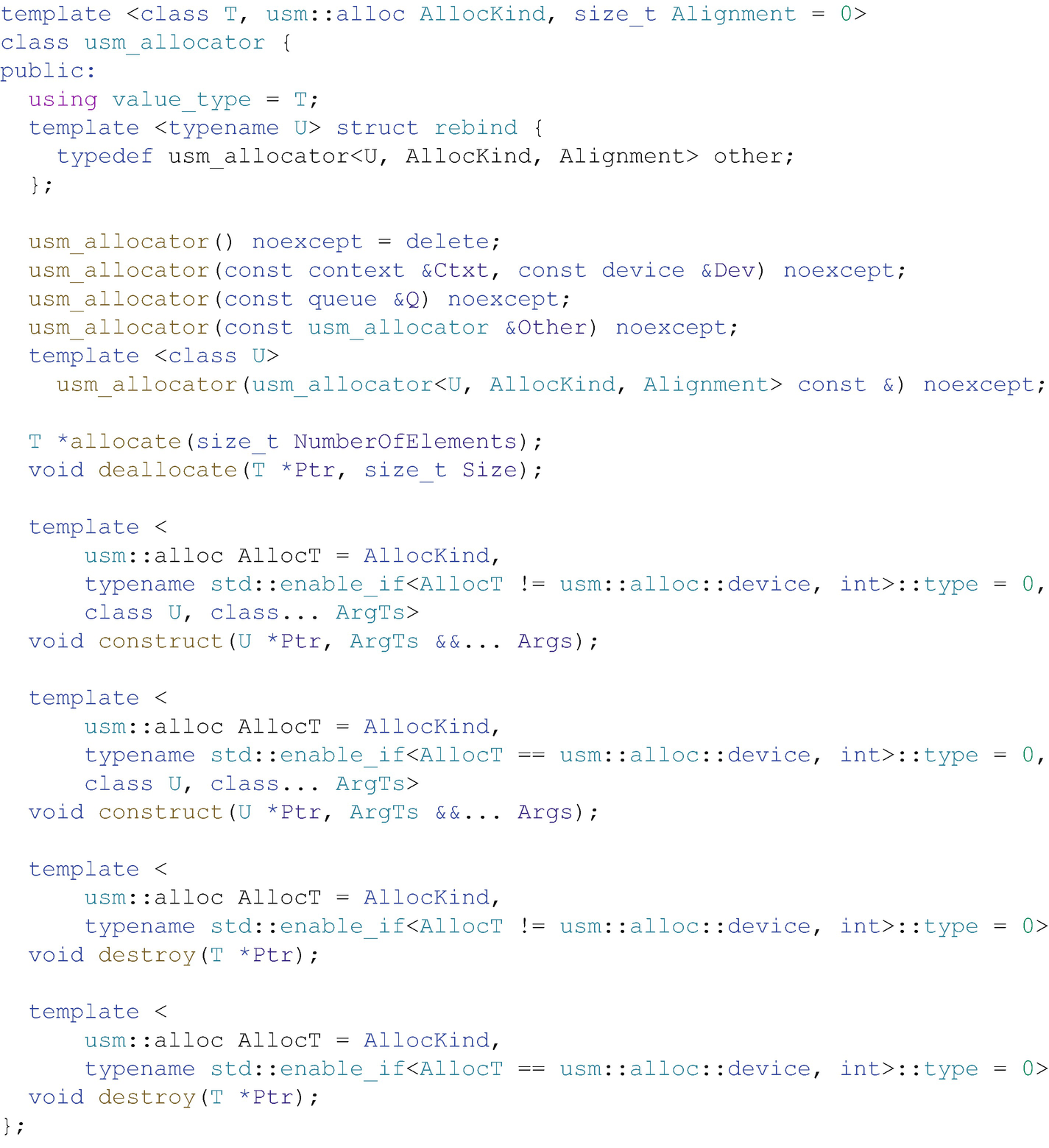
C++ allocator–style USM allocation functions
Deallocating Memory
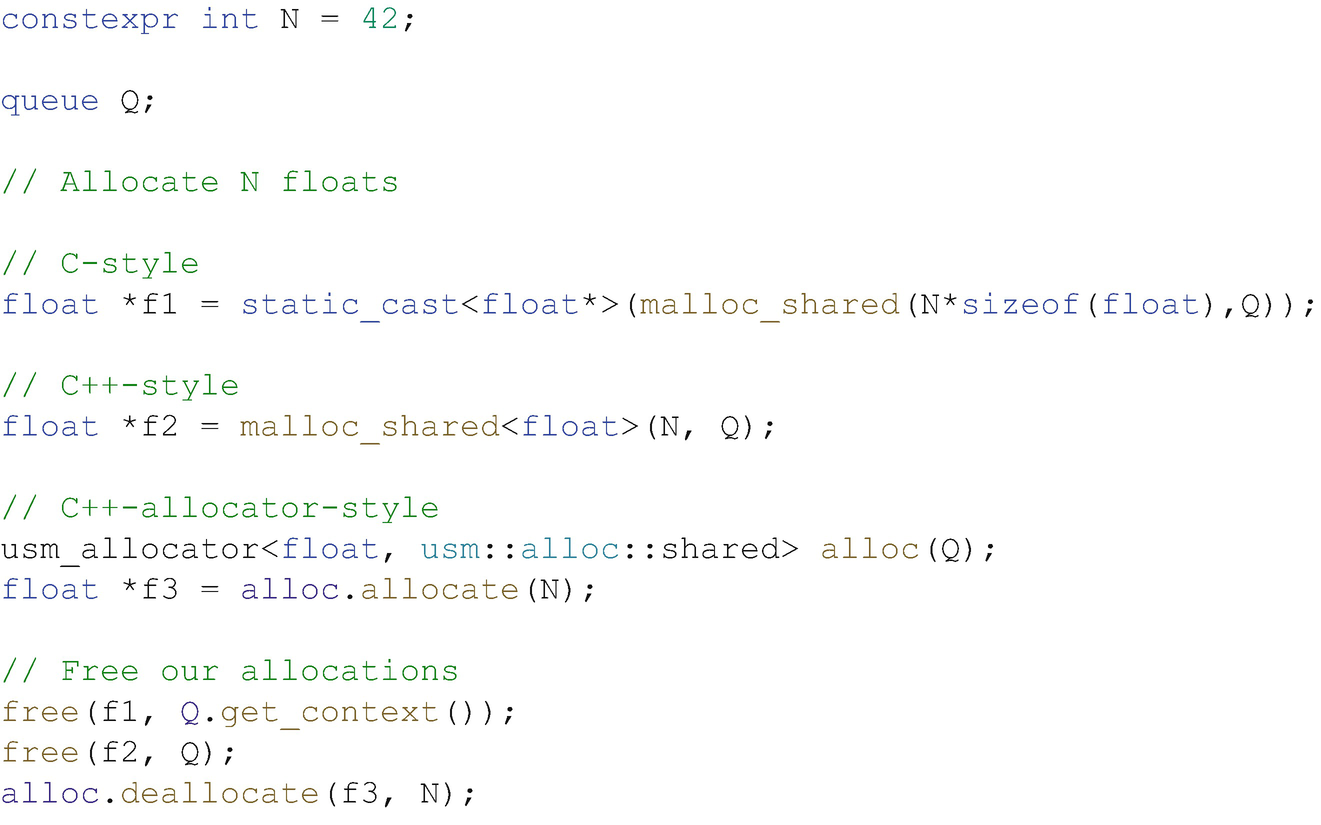
Three styles for allocation
Allocation Example
In Figure 6-5, we show how to perform the same allocation using the three styles just described. In this example, we allocate N single-precision floating-point numbers as shared allocations. The first allocation f1 uses the C-style void * returning malloc routines. For this allocation, we explicitly pass the device and context that we obtain from the queue. We must also cast the result back to a float *. The second allocation f2 does the same thing but using the C++-style templated malloc. Since we pass the type of our elements, float, to the allocation routine, we only need to specify how many floats we want to allocate, and we do not need to cast the result. We also use the form that takes the queue instead of the device and context, yielding a very simple and compact statement. The third allocation f3 uses the USM C++ allocator class. We instantiate an allocator object of the proper type and then perform the allocation using that object. Finally, we show how to properly deallocate each allocation.
Data Management
Now that we understand how to allocate memory using USM, we will discuss how data is managed. We can look at this in two pieces: data initialization and data movement.
Initialization
Data initialization concerns filling our memory with values before we perform computations on it. One example of a common initialization pattern is to fill an allocation with zeroes before it is used. If we were to do this using USM allocations, we could do it in a variety of ways. First, we could write a kernel to do this. If our data set is particularly large or the initialization requires complex calculations, this is a reasonable way to go since the initialization can be performed in parallel (and it makes the initialized data ready to go on the device). Second, we could implement this as a loop over all the elements of an allocation that sets each to zero. However, there is potentially a problem with this approach. A loop would work fine for host and shared allocations since these are accessible on the host. However, since device allocations are not accessible on the host, a loop in host code would not be able to write to them. This brings us to the third option.
The memset function is designed to efficiently implement this initialization pattern. USM provides a version of memset that is a member function of both the handler and queue classes. It takes three arguments: the pointer representing the base address of the memory we want to set, a byte value representing the byte pattern to set, and the number of bytes to set to that pattern. Unlike a loop on the host, memset happens in parallel and also works with device allocations.
While memset is a useful operation, the fact that it only allows us to specify a byte pattern to fill into an allocation is rather limiting. USM also provides a fill method (as a member of the handler and queue classes) that lets us fill memory with an arbitrary pattern. The fill method is a function templated on the type of the pattern we want to write into the allocation. Template it with an int, and we can fill an allocation with the number “42”. Similar to memset, fill takes three arguments: the pointer to the base address of the allocation to fill, the value to fill, and the number of times we want to write that value into the allocation.
Data Movement
Data movement is probably the most important aspect of USM to understand. If the right data is not in the right place at the right time, our program will produce incorrect results. USM defines two strategies that we can use to manage data: explicit and implicit. The choice of which strategy we want to use is related to the types of USM allocations our hardware supports or that we want to use.
Explicit
The first strategy USM offers is explicit data movement (Figure 6-6). Here, we must explicitly copy data between the host and device. We can do this by invoking the memcpy method, found on both the handler and queue classes. The memcpy method takes three arguments: a pointer to the destination memory, a pointer to the source memory, and the number of bytes to copy between host and device. We do not need to specify in which direction the copy is meant to happen—this is implicit in the source and destination pointers.
The most common usage of explicit data movement is copying to or from device allocations in USM since they are not accessible on the host. Having to insert explicit copying of data does require effort on our part. Additionally, it can be a source of bugs: copies could be accidentally omitted, an incorrect amount of data could be copied, or the source or destination pointer could be incorrect.
However, explicit data movement does not only come with disadvantages. It gives us large advantage: total control over data movement. Control over both how much data is copied and when the data gets copied is very important for achieving the best performance in some applications. Ideally, we can overlap computation with data movement whenever possible, ensuring that the hardware runs with high utilization.
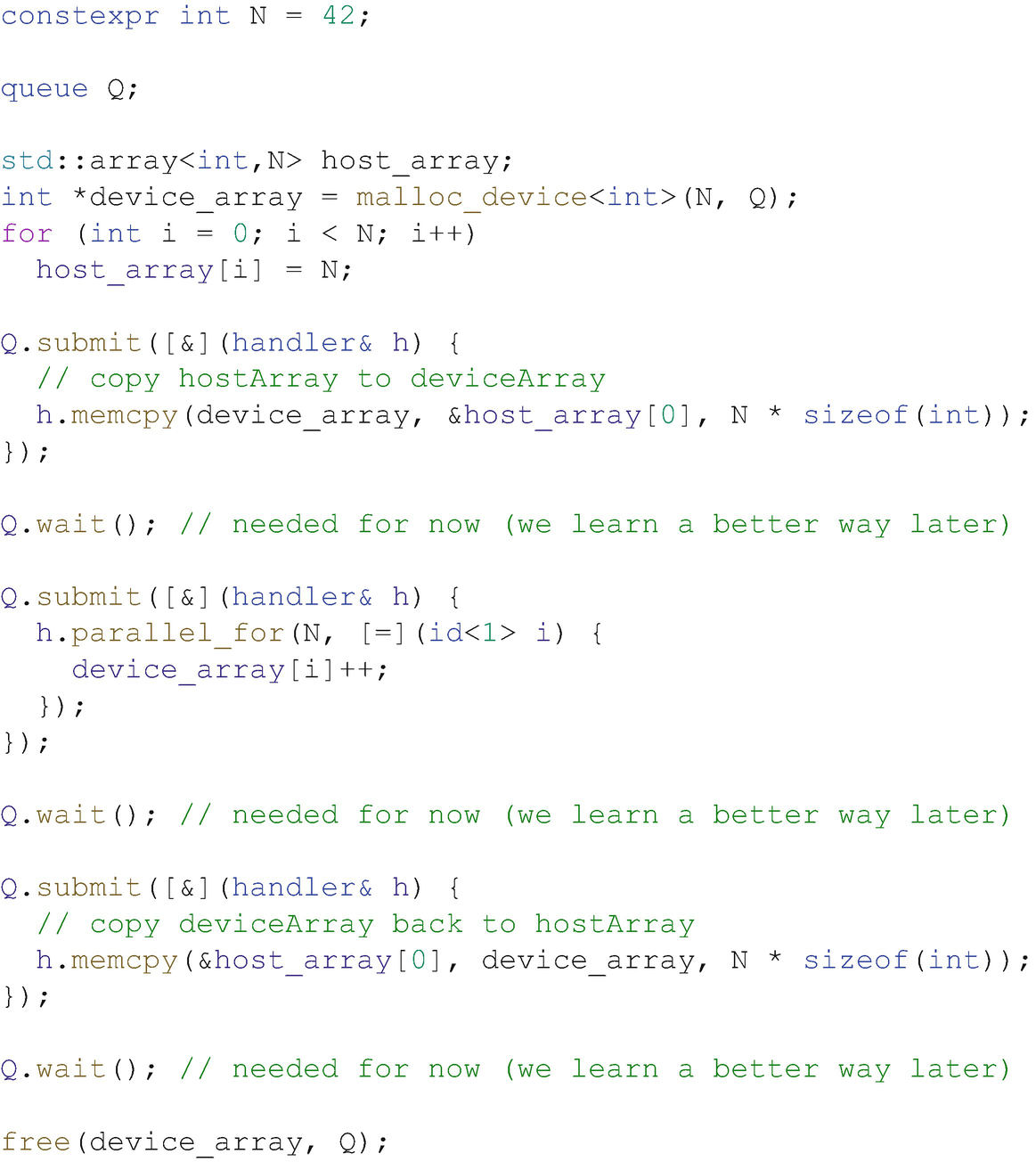
USM explicit data movement example
Implicit
The second strategy that USM provides is implicit data movement (example usage shown in Figure 6-7). In this strategy, data movement happens implicitly, that is, without requiring input from us. With implicit data movement, we do not need to insert calls to memcpy since we can directly access the data through the USM pointers wherever we want to use it. Instead, it becomes the job of the system to ensure that the data will be available in the correct location when it is being used.
With host allocations, one could argue whether they really cause data movement. Since, by definition, they always remain pointers to host memory, the memory represented by a given host pointer cannot be stored on the device. However, data movement does occur as host allocations are accessed on the device. Instead of the memory being migrated to the device, the values we read or write are transferred over the appropriate interface to or from the kernel. This can be useful for streaming kernels where the data does not need to remain resident on the device.
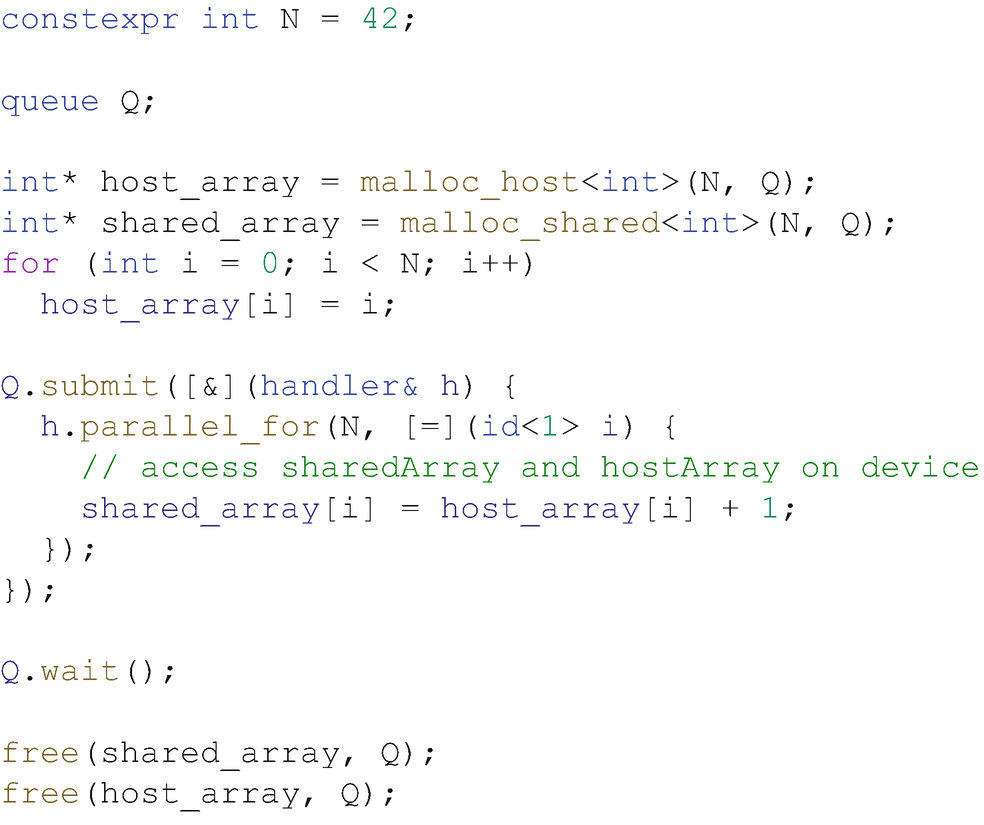
USM implicit data movement example
Migration
With explicit data movement, we control how much data movement occurs. With implicit data movement, the system handles this for us, but it might not do it as efficiently. The DPC++ runtime is not an oracle—it cannot predict what data an application will access before it does it. Additionally, pointer analysis remains a very difficult problem for compilers, which may not be able to accurately analyze and identify every allocation that might be used inside a kernel. Consequently, implementations of the mechanisms for implicit data movement may make different decisions based on the capabilities of the device that supports USM, which affects both how shared allocations can be used and how they perform.
If a device is very capable, it might be able to migrate memory on demand. In this case, data movement would occur after the host or device attempts to access an allocation that is not currently in the desired location. On-demand data greatly simplifies programming as it provides the desired semantic that a USM shared pointer can be accessed anywhere and just work. If a device cannot support on-demand migration (Chapter 12 explains how to query a device for capabilities), it might still be able to guarantee the same semantics with extra restrictions on how shared pointers can be used.
The restricted form of USM shared allocations governs when and where shared pointers may be accessed and how big shared allocations can be. If a device cannot migrate memory on demand, that means the runtime must be conservative and assume that a kernel might access any allocation in its device attached memory. This brings a couple of consequences.
First, it means that the host and device should not try to access a shared allocation at the same time. Applications should instead alternate access in phases. The host can access an allocation, then a kernel can compute using that data, and finally the host can read the results. Without this restriction, the host is free to access different parts of an allocation than a kernel is currently touching. Such concurrent access typically happens at the granularity of a device memory page. The host could access one page, while the device accesses another. Atomically accessing the same piece of data will be covered in Chapter 19.
The next consequence of this restricted form of shared allocations is that allocations are limited by the total amount of memory attached to a device. If a device cannot migrate memory on demand, it cannot migrate data to the host to make room to bring in different data. If a device does support on-demand migration, it is possible to oversubscribe its attached memory, allowing a kernel to compute on more data than the device’s memory could normally contain, although this flexibility may come with a performance penalty due to extra data movement.
Fine-Grained Control
When a device supports on-demand migration of shared allocations, data movement occurs after memory is accessed in a location where it is not currently resident. However, a kernel can stall while waiting for the data movement to complete. The next statement it executes may even cause more data movement to occur and introduce additional latency to the kernel execution.
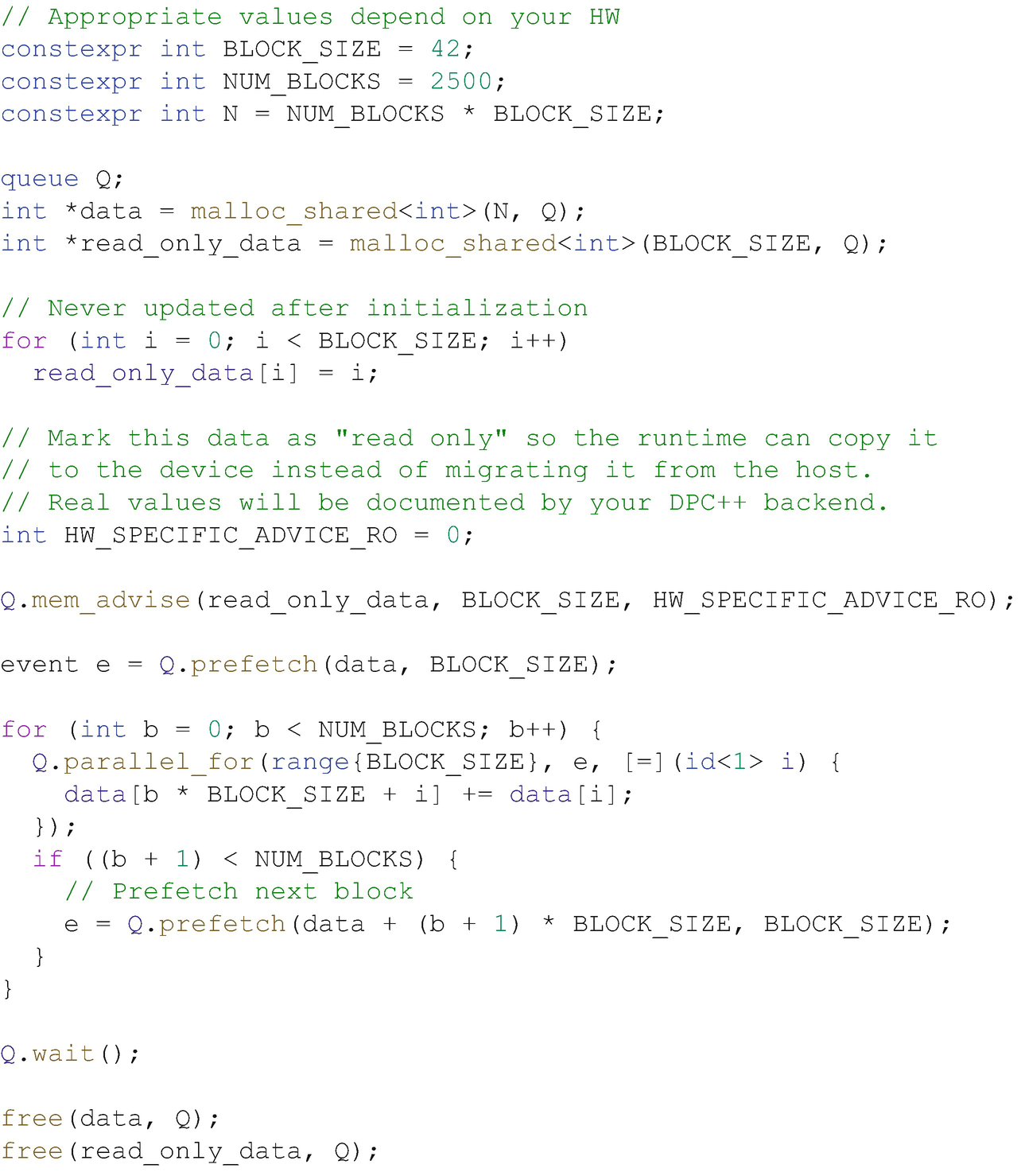
Fine-grained control via prefetch and mem_advise
The simplest way for us to do this is by invoking prefetch . This function is invoked as a member function of the handler or queue class and takes a base pointer and number of bytes. This lets us inform the runtime that certain data is about to be used on a device so that it can eagerly start migrating it. Ideally, we would issue these prefetch hints early enough such that by the time the kernel touches the data, it is already resident on the device, eliminating the latency we previously described.
The other function provided by DPC++ is mem_advise . This function allows us to provide device-specific hints about how memory will be used in kernels. An example of such possible advice that we could specify is that the data will only be read in a kernel, not written. In that case, the system could realize it could copy, or duplicate, the data on the device, so that the host’s version does not need to be updated after the kernel is complete. However, the advice passed to mem_advise is specific to a particular device, so be sure to check the documentation for hardware before using this function.
Queries
Finally, not all devices support every feature of USM. We should not assume that all USM features are available if we want our programs to be portable across different devices. USM defines several things that we can query. These queries can be separated into two categories: pointer queries and device capability queries. Figure 6-9 shows a simple utilization of each.
The pointer queries in USM answer two questions. The first question is “What type of USM allocation does this pointer point to?” The get_pointer_type function takes a pointer and DPC++ context and returns a result of type usm::alloc , which can have four possible values: host, device, shared, or unknown. The second question is “What device was this USM pointer allocated against?” We can pass a pointer and a context to the function get_pointer_device and get back a device object. This is mostly used with device or shared USM allocations since it does not make much sense with host allocations.
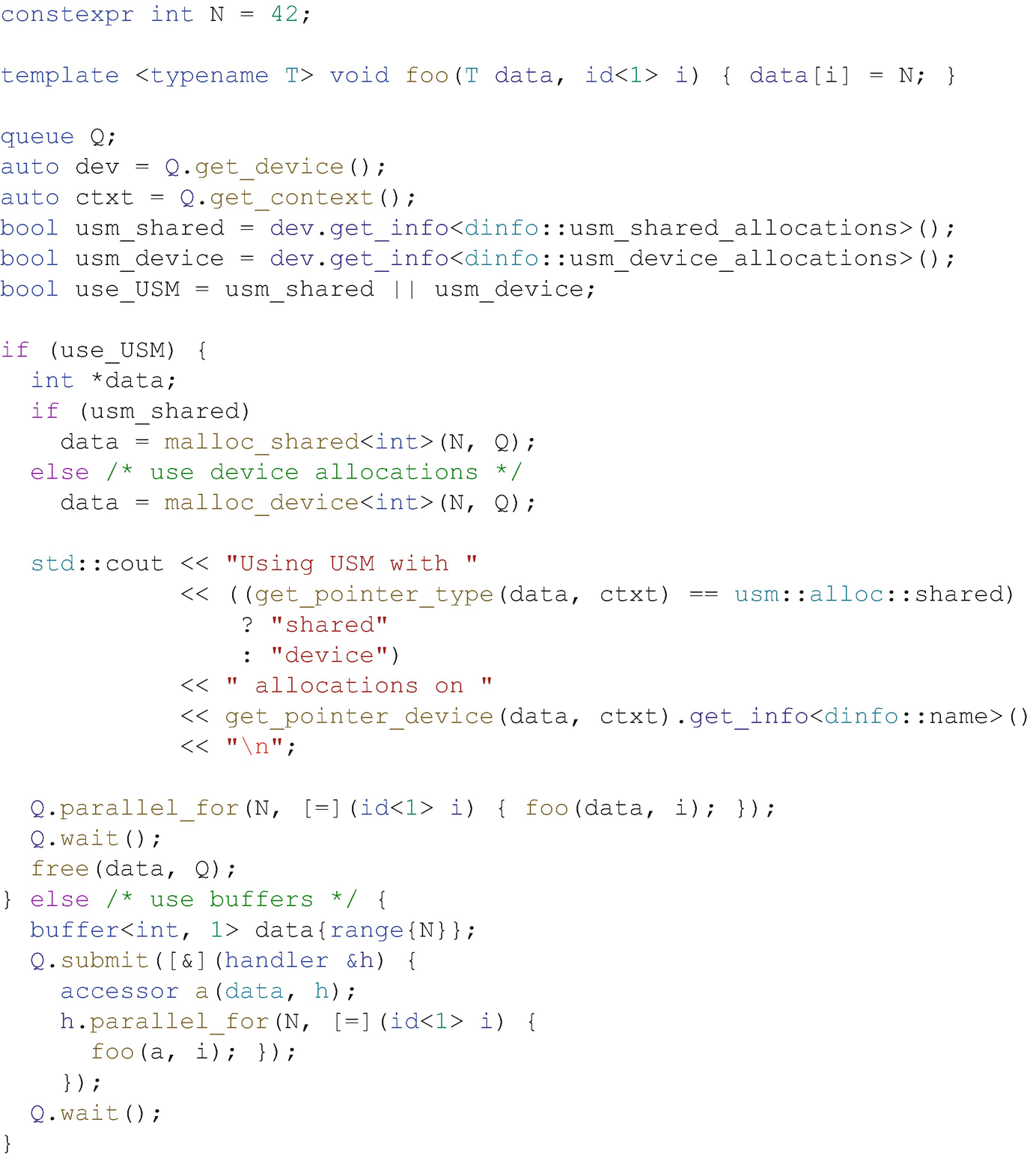
Queries on USM pointers and devices

USM device information descriptors
Summary
In this chapter, we’ve described Unified Shared Memory, a pointer-based strategy for data management. We covered the three types of allocations that USM defines. We discussed all the different ways that we can allocate and deallocate memory with USM and how data movement can be either explicitly controlled by us (the programmers) for device allocations or implicitly controlled by the system for shared allocations. Finally, we discussed how to query the different USM capabilities that a device supports and how to query information about USM pointers in a program.
Since we have not discussed synchronization in this book in detail yet, there is more on USM in later chapters when we discuss scheduling, communications, and synchronization. Specifically, we cover these additional considerations for USM in Chapters 8, 9, and 19.
In the next chapter, we will cover the second strategy for data management: buffers.

Open Access This chapter is licensed under the terms of the Creative Commons Attribution 4.0 International License (http://creativecommons.org/licenses/by/4.0/), which permits use, sharing, adaptation, distribution and reproduction in any medium or format, as long as you give appropriate credit to the original author(s) and the source, provide a link to the Creative Commons license and indicate if changes were made.
The images or other third party material in this chapter are included in the chapter's Creative Commons license, unless indicated otherwise in a credit line to the material. If material is not included in the chapter's Creative Commons license and your intended use is not permitted by statutory regulation or exceeds the permitted use, you will need to obtain permission directly from the copyright holder.